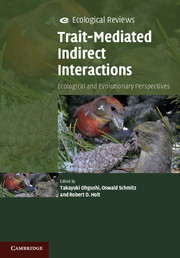Book contents
- Frontmatter
- Contents
- Contributors
- Foreword
- Preface
- Chapter One Introduction
- Part I Community
- Chapter Two Perspective
- Chapter Three Consequences of trait changes in host–parasitoid interactions in insect communities
- Chapter Four The impact of trait-mediated indirect interactions in marine communities
- Chapter Five Trait-mediated indirect interactions in size-structured populations
- Chapter Six Trait-mediated effects, density dependence and the dynamic stability of ecological systems
- Chapter Seven Plant effects on herbivore–enemy interactions in natural systems
- Chapter Eight The implications of adaptive prey behaviour for ecological communities
- Chapter Nine Community consequences of phenotypic plasticity of terrestrial plants
- Chapter Ten Model-based, response-surface approaches to quantifying indirect interactions
- Part II Coevolution
- Part III Ecosystem
- Part IV Applied Ecology
- Index
- Plate Section
- References
Chapter Nine - Community consequences of phenotypic plasticity of terrestrial plants
herbivore-initiated bottom-up trophic cascades
Published online by Cambridge University Press: 05 February 2013
- Frontmatter
- Contents
- Contributors
- Foreword
- Preface
- Chapter One Introduction
- Part I Community
- Chapter Two Perspective
- Chapter Three Consequences of trait changes in host–parasitoid interactions in insect communities
- Chapter Four The impact of trait-mediated indirect interactions in marine communities
- Chapter Five Trait-mediated indirect interactions in size-structured populations
- Chapter Six Trait-mediated effects, density dependence and the dynamic stability of ecological systems
- Chapter Seven Plant effects on herbivore–enemy interactions in natural systems
- Chapter Eight The implications of adaptive prey behaviour for ecological communities
- Chapter Nine Community consequences of phenotypic plasticity of terrestrial plants
- Chapter Ten Model-based, response-surface approaches to quantifying indirect interactions
- Part II Coevolution
- Part III Ecosystem
- Part IV Applied Ecology
- Index
- Plate Section
- References
Summary
Introduction
Much of earth’s biodiversity is composed of species that feed on plants, and in turn these herbivores are the prey base for predatory species. A high diversity of herbivores may support a high diversity of parasites and predators, thus potentially allowing the diversity of plants to cascade upwards to higher trophic levels (Hunter and Price 1992). It is well accepted that increasing the species diversity and/or functional diversity of terrestrial plants leads to greater species diversity of herbivorous and predacious arthropods (Haddad et al. 2009; Scherber et al. 2010). Moreover, studies of community genetics have shown that genetic variation within a plant species or hybrid zone can greatly influence the species richness and abundance of arthropods associated with the plant (Whitham et al. 2006).
It is important to recognize that the herbivore-induced phenotypic plasticity of plants can generate plant-based resource variation, and that these phenotypic variations within a plant species can potentially have a strong bottom-up effect on the community structure and biodiversity of arthropods (Ohgushi 2005). Different plant phenotypes offer distinct niches enabling arthropods to coexist, which leads to the hypothesis that a plant population with high phenotypic diversity would offer a greater variety of niches for arthropods than a population with low phenotypic diversity, and this would result in a greater diversity and an altered community structure of arthropods.
- Type
- Chapter
- Information
- Trait-Mediated Indirect InteractionsEcological and Evolutionary Perspectives, pp. 161 - 185Publisher: Cambridge University PressPrint publication year: 2012
References
- 11
- Cited by

